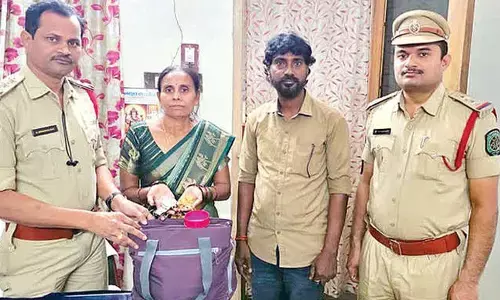Ramappa - A Symphony in Stone

Ramappa - A Symphony in Stone
To describe the temple of Ramappa is to demonstrate the inadequacy of the written word.
To describe the temple of Ramappa is to demonstrate the inadequacy of the written word. Historians and pundits of architecture have attempted what may be termed a technical exposition of this remarkable structure. But they have failed to conjure up even a faint picture of the temple and its wealth of artistry and breath - taking beauty. What the eye sees, nothing else can fully convey.
From the headquarters of the "Lake district" of Andhra Pradesh viz., Warangal, a road runs, to Mulug and beyond-a predominantly forest area. After traversing about 32 miles from Warangal, your car turns left and proceeds along a difficult road in the vicinity of the reserve forest. Then you come across a small village called Palampet whose present appearance hardly suggests that it was once a flourishing city.
Passing through Palampet, a little to the left you suddenly see the rear view of the huge temple. There is an indescribable quality about this view— like some mythical bird, on its perch, about to fly into the clear sky above. Crossing a six-foot-wide irrigation canal which takes off from the Ramappa lake and runs close to the rear compound wall of the temple, you enter the compound through a low and narrow doorway. This back door entry is obviously of recent origin, the mukhamandapa (nandimandapa) and the main gate being on the opposite side in front of the temp
The shrines at Palampet belong to the period of the Kakatiyas and constitute perhaps the finest examples of medieval Deccan temples. The early Kakatiyas, Beta I and Prola I, Beta II and Prola II, distinguished themselves as vassals under the Western Chalukyan emperors. Rudradeva, son of Prola II, declared his independence, and acquired new territories. Being childless, he was succeeded by his younger brother after whom Ganapati, the greatest of the Kakatiya family, became the monarch. Ganapati was a great conqueror. By his prowess, he enlarged the frontiers of his kingdom up to the Kaveri in the south and up to the sea in the east. In this task he was helped by a number of able generals and ministers, of whom Rudra of the Recherla family is famous. The temples of Palampet were the pious works of this chief, Rudra. His inscription running to nearly 204 lines engraved on four sides of a polished basalt pillar now erected in a small mandapa within the court yard of the temples, enumerates the glorious achievements of this feudatory family and Commemorates the construction of the main temples at Palampet in Saka 1135 by Rudra It is therefore a very important document not only for dating the temples of Ramappa but also for furnishing much-needed data on the history of this place.
The temple complex consists of the main shrine dedicated to Siva with the nandimandapa in front. This mandapa is now in ruins. The huge nandi, installed here is at the entrance to the temple. A unique feature of this nandi is that from which angle you look at its face, it appears to be looking at you.
The main temple which stands on large Jagati, 6' 4" high, supported the sanctum (garbhagriha), the ardhamandapa or antarala and the mahamandapa or "ranga mandapa" with seven devakostas or subsidary shrines arranged along the sides of the mandapa. Originally there should have been eight devakostas, perhaps enshrining ten parivara devatas. Mahamandapa which is at the end has kakshasanas, running around except at the porches which are added to serve as entrances. There are porticos on the east, north and south.
Above the top of these devakostas there is a hamsamala over which runs the kapota or cornice. The wall-top is covered by a projecting chajja which runs all round the temple. The inner surface of the chajja is panelled into a diminishing rectangle with raised sides of rims. All along the run are arranged lotus buds as pendants or as ornaments for the curved undersides. The outer face of the parapet (or kakshasanas) that run round the mahamandapa is divided into four horizontal sections in which are depicted rows of elephants (mattavarana), vajrabandha-dancers, musicians, gods, rishis, mithunas, etc.
The vimana or superstructure over the cella is built of sponge-like brick which floats on water. This brick was obviously meant for a light-weight vimana. Visitors have been so impressed by the quality of the brick that they have, over the decades, denuded the superstructure of almost every removable brick to see it float on the adjacent canal. Today the chowkidar keeps a sample brick for purposes of demonstration, and visitors are not allowed to dig the superstructure to satisfy their curiosity. The vimana is divided into four bhumis or talas of reducing dimensions over which, on a narrow griva, rises a domical sikhara with prominent nasikas on all the four sides. The superstructure over the antarala (arddhamandapa) has similar decorations and forms an undifferentiated shukanasi. The constructions of the main sikhara is what Fergusson calls "a compromise between the styles of the north and south., the tigers of pillars rising vertically give the structure an Indo-Aryan appearance while the railings and the bold cornices have horizontal courses characteristic of the Dravidian style".
The temple's sculptural decoration, especially the depiction of human activities, shows fresh charm, elegance and almost a metallic finish. The perforated screen pattern on the ranks of the door jambs, female figures in various dancing poses, besides the chauri-bearers and dvarapalas standing cross-legged, pulsating with life and movement, all display the supreme workmanship accomplished by the sculptor of that age. The dvarasakhas above the doorway are covered with the figures of ornamental vimanas or navagraha panels. There is also a short musical pillar on the right flank of the entrance to the antarala. The presiding deity, Rudresvara, symbolised in the mystic linga, stands on a high pedestal yonipitha, of highly polished black basalt, in the centre of the cella.
The pillars of the mahamandapa divide the ceiling into several compartments, each being superbly carved with decorations ranging from floral and geometrical patterns and full-blown lotuses to the highl y intricate honeycomb scroll. The ornamentation of the central pillars and the architrave above them is rich, subtle and fine like exquisite filigree work in gold or silver indeed, In the hands of the sculptors, the hard black basalt virtually attained the softness of wax and the polish of clean mirror. The pillars of the central mandapa are highly ornate-cubical at the bottom, octagonal and circular bands covered with processions of musicians and dancers in the middle with a square section above on the face of which are depicted scenes of the Gopika Vastrapaharana etc., from the Bhagavatha, and a tapering top surmounted with a pitha and the corbel. The pitha is beautifully covered with flowing pearl tassels
while the corbels are plain, with rolled or chamfered ends. The beams and the ceiling above are all covered with figure sculpture, depicting scenes from mythology, the puranas and agamic texts. The general spirit of the sculpture, as suggested by an expert is somewhat sensual and exhibits erotic joy. However when compared with similar sculptures of the contemporary temples of Central India or Orissa - particularly Khajuraho or Bhubaneswar - this temple certainly shows the restraint of the artist of the Kakatiyas, though he could not divorce himself from the spirit of the age.
A striking feature of this temple is the figure brackets springing from the shoulders (virakantha) of the outer pillars shown supporting the ponder- ous chajja slabs. Twelve of them consist of female figures, almost life-size, worked in highly polished black basalt, cut with great precision and accuracy, There is an exuberance of youth with unfettered emotion in these figures. Particularly striking is a nude (study) of a lovely nagini with legs gracefully extended at full length, hands lifted slightly to bring into relief a charmingly youthful bosom. The figure has been given an apt Telugu nickname, viz., Garabala patti meaning the darling damsel. The beauty of this figure is indeed so irresistible that a district collector, in the old Nizam's Government, is said to have removed it to adorn his private residence. It was after a good deal of public agitation that the figure was returned and restored to its old position.
The buildings are grandly executed. The high plinth, lofty pillars, spacious halls, ponderous beams, ceiling slabs, majestic sikhara, and figure sculpture speak volumes about the high perfection reached by the sculptor and architect of the age. The Kakatiya sthapati not only mastered the idiom of the earlier Chalukya school but adapted it to the change in taste of the people of his own age, without silpasastrakarins of the period.
This description will remain incomplete without a reference to the big and beautiful Ramappa lake nearby. The lush forest, the lake, the temple complex and the over-all atmosphere present a picture of serenity blended with beauty. To every tourist and scholar this specimen of Kakatiya culture serves as a rewarding revelation.
(The author was the Prime Minister of India. This article which was originally published in the Illustrated Weekly of lndia, the issue of Sept. 11,1966, has been reproduced here as a tribute to him on the occasion of World Heritage Day today.)

















